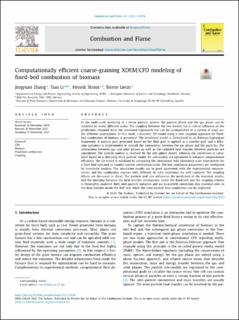| dc.contributor.author | Zhang, Jingyuan | |
| dc.contributor.author | Li, Tian | |
| dc.contributor.author | Ström, Henrik | |
| dc.contributor.author | Løvås, Terese | |
| dc.date.accessioned | 2022-01-04T13:16:10Z | |
| dc.date.available | 2022-01-04T13:16:10Z | |
| dc.date.created | 2021-12-14T14:11:46Z | |
| dc.date.issued | 2022 | |
| dc.identifier.citation | Combustion and Flame. 2022, 238, . | en_US |
| dc.identifier.issn | 0010-2180 | |
| dc.identifier.uri | https://hdl.handle.net/11250/2836004 | |
| dc.description.abstract | In the multi-scale modeling of a dense particle system, the particle phase and the gas phase can be modeled on vastly different scales. The coupling between the two models has a critical influence on the predictions obtained from the combined framework but can be accomplished in a variety of ways under different assumptions. In this work, a transient 3D model using a new coupling approach for fixed-bed combustion of biomass is presented. The developed model is formulated as an Eulerian-Lagrangian framework. A particle grid, generated based on the fluid grid, is applied as a transfer grid, and a diffusion operation is implemented to smooth the interactions between the gas phase and the particles. The interactions between gas and solid phases as well as the radiative heat transfer between particles are considered. The particle motion is resolved by the soft-sphere model, whereas the conversion is calculated based on a thermally thick particle model. All sub-models are optimized to enhance computational efficiency. The 3D model is validated by comparing the simulations with laboratory-scale experiments for a fixed-bed operated in counter-current combustion mode. The key simulation parameters are configured by sensitivity analysis. The simulation results are in good agreement with the experimental measurements, and the combustion regimes with different air inlet conditions are well captured. The coupling effects are discussed in detail. The particle grid size influences the prediction of the transient results, and the interplay between the heat transfer mechanisms inside the fixed-bed and the coupling scheme is thoroughly analyzed. Both inter-particle radiation and gas-to-particle convection play essential roles in the heat transfer inside the fuel bed, while the inter-particle heat conduction can be neglected. | en_US |
| dc.language.iso | eng | en_US |
| dc.publisher | Elsevier Science | en_US |
| dc.rights | Navngivelse 4.0 Internasjonal | * |
| dc.rights.uri | http://creativecommons.org/licenses/by/4.0/deed.no | * |
| dc.title | Computationally efficient coarse-graining XDEM/CFD modeling of fixed-bed combustion of biomass | en_US |
| dc.type | Peer reviewed | en_US |
| dc.type | Journal article | en_US |
| dc.description.version | publishedVersion | en_US |
| dc.source.volume | 238 | en_US |
| dc.source.journal | Combustion and Flame | en_US |
| dc.identifier.doi | https://doi.org/10.1016/j.combustflame.2021.111876 | |
| dc.identifier.cristin | 1968402 | |
| dc.relation.project | Norges forskningsråd: 267957 | en_US |
| dc.source.articlenumber | 111876 | en_US |
| cristin.ispublished | true | |
| cristin.fulltext | original | |
| cristin.qualitycode | 2 | |

